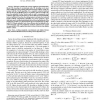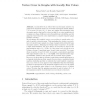65 search results - page 10 / 13 » Finding maximum degrees in hidden bipartite graphs |
TIT
2008
13 years 8 months ago
2008
Abstract--This letter considers the average complexity of maximum-likelihood (ML) decoding of convolutional codes. ML decoding can be modeled as finding the most probable path take...
CCCG
2007
13 years 10 months ago
2007
In this paper, we consider the following graph embedding problem: Given a bipartite graph G = (V1, V2; E), where the maximum degree of vertices in V2 is 4, can G be embedded on a t...
ESA
2006
Springer
14 years 7 days ago
2006
Springer
A coloring is proper if each color class induces connected components of order one (where the order of a graph is its number of vertices). Here we study relaxations of proper two-c...
ICALP
2011
Springer
13 years 1 days ago
2011
Springer
In [13], Erd˝os et al. defined the local chromatic number of a graph as the minimum number of colors that must appear within distance 1 of a vertex. For any ∆ ≥ 2, there are ...
ICALP
2009
Springer
14 years 8 months ago
2009
Springer
We introduce a generic approach for counting subgraphs in a graph. The main idea is to relate counting subgraphs to counting graph homomorphisms. This approach provides new algori...


